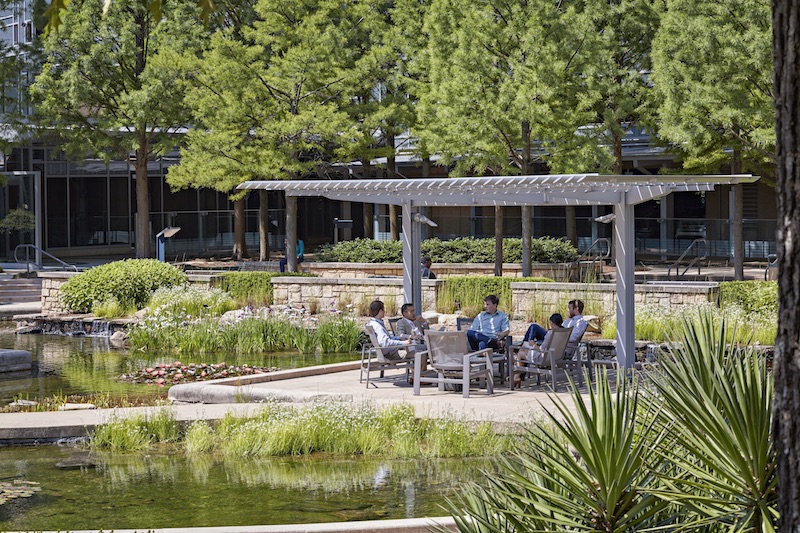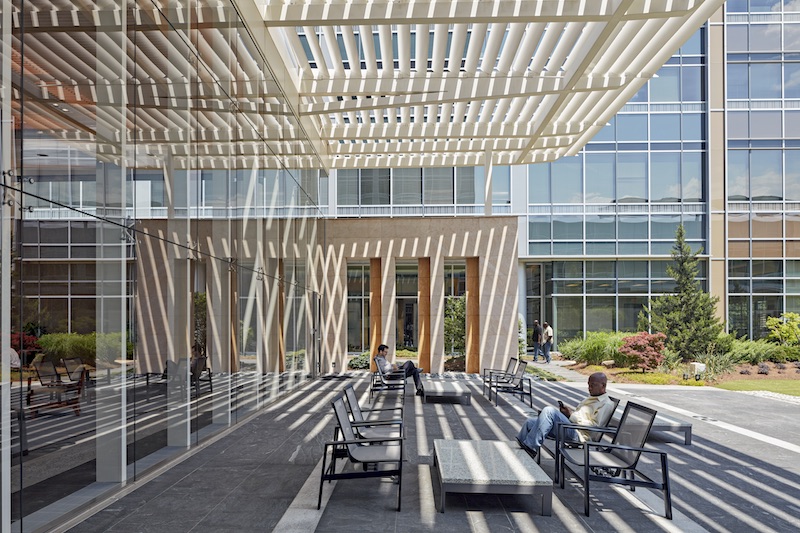A generational shift and advances in technology are changing the work environment. Corporate America seeks to draw young workers who, rather than swinging hammers, wield mobile devices to generate ideas and produce results. Today’s college graduates have experienced an environment with more amenities than ever before, and with them comes new expectations about the workplace: “I'm going to work the way I want. I'm going to come up with an idea with my buddies at Starbucks and revolutionize the things." This is the new and pervasive culture that is redefining corporate architecture.
Much has been written about the Millennial generation. Their emergence into the working world comes with a sense of openness for all. Thus, the challenge is more than designing building and spaces to attract, inspire and retain one micro-generation. Today’s workplace requires designers and employers to look holistically at the organization’s culture, its criteria for success, and its place in the world. Shaping an effective workplace is about more than rethinking its architecture. Designers must push beyond the idea of ‘this is the way we do it here’ and drill down to the intentions and vision for that specific business.
Out-of-the-Cubicle
Technology has altered the work process, and in many ways its product, but the rules of workplace engagement have changed too. What is today’s expectation of how we should work? Not long ago, an employee was given a task and went to their office or cubicle to accomplish it. The employee with their ‘nose to the grindstone’ was the ideal. Today’s model says, "Yes, an employee sits in that spot, but also makes impactful contact with others." At McKinney, an advertising firm in Durham, creative directors have the smallest offices and aren’t expected to be in their office until after 5 o'clock; they're expected to be out talking to their teams.
The push for mobility and flexibility is not tied to any one generation or corporate level. Now, even CEOs are taking their laptops and smartphones to Starbucks in search of a different type of space. People crave the freedom to move around, within, and beyond a designated space. Many clients still want private offices, but they’re also looking for areas to collaborate and varied meeting spaces. Some companies are reducing office size because they want employees out in the organization or the community, not behind a desk.
With more than just a nod to office redesign, companies are relocating from the suburban areas to more central locations near public transportation and amenities. These metro locations place them closer to the people they want to hire and retain—an exciting, urban minded, and creative new workforce. But this trend is about more than just convenience: a 2015 survey of Millennials found 77% choose a workplace based partly on whether the company has “a sense of purpose,” and revitalizing neglected urban centers is considered both green and socially responsible. The trend toward urbanization is an environmental plus, because city dwellers drive less, live in spaces that use less energy, and require fewer resources than their suburban counterparts.
 Courtesy Robert Benson Photography.
Courtesy Robert Benson Photography.
Creativity’s Stock is Up
Creativity in the workplace is no longer an option. On the heels of successful enterprises such as Apple and Google, fostering creativity expands an organization’s potential. More traditional corporate cultures—law firms, sales organizations, and service companies—have made significant advancements in valuing creativity. But how is creativity added to a culture that never had it before? Simply adding a new collaboration or creative space and assuming staff, who come from a traditional work world, will change their behavior is a fallacy and can cause skepticism.
Reflecting and facilitating creativity in the workplace means allowing for flexibility and different working styles, and both aid in accommodating all levels of diversity. Space for moving around, getting out of an individual workspace and talking as a group, and collaborating with multiple team members requires different types of spaces and furnishing. The Dilbert-type cubicle is the antithesis of creativity. Take away the cubicle and people are suddenly in the same room together. Then, it's not just fulfilling a task— the individual is in a place where the metrics are group oriented. This is where creativity kicks in, and that's how the business world is transforming. Most architectural and design firms utilize open studios for exactly this reason.
Open, flexible space is advantageous for organizations, which can function like a workplace laboratory, modifying and adapting to changing needs. For example, rather than just adding conference rooms, multifunction spaces simply do more: roof terraces, café, breakout, and meditation areas allow equally for meetings, conferencing, and individual focus. GlaxoSmithKline recently put ‘phone rooms’ into their offices, so employees have a private place to use their cellphones. And they aren’t alone as companies as diverse as Slate Magazine as well as laboratories and construction companies make way for a variety of diverse, flexible spaces.
 Courtesy Duda|Paine Architects.
Courtesy Duda|Paine Architects.
Architecture and HR
Today, mobility and flexibility free staff to work where, when, and how they want, but that freedom has eroded our sense of where work stops. ‘Office hours’ can mean 24/7 with the technology created in just one generation. Employees must become stewards of their own work/life balance. In response, companies are thinking more holistically and asking architecture to project this new attitude.
Shaping the right office environment is an investment and a company’s best recruiting tool. At Cox Headquarters, a prospective recruit is typically convinced after a tour of the amenity rich campus, which in addition to a gym and café options, includes landscaped gardens. Cox’s goal is to do more than recruit great employees, it's retention.
The new generation employee also cares more about health and is infinitely more informed on the topic than previous generations. With their professional expectations and spatial needs shaped by experiences in education, they see the balance between good health and good work as essential. Connecting a work environment more directly to the outdoors, as Cox has done, is one approach.
Making Work Visible
An e-blast might not be the best way to showcase an organization’s work. More and more organizations are looking to gallery spaces and ‘innovation halls’ to showcase what they do to the public, future recruits, and staff. The idea of being able to see what people in a company are working on opens everyone to being informed and inspired. At the award-winning John Deere Moline headquarters, Eero Saarinen and Kevin Roche made a conscious decision for staff members to enter the headquarters building through a two-story museum, which includes a 3-dimensional mural of the company’s history, as well as vintage and new tractors, bulldozers, and other equipment. Thus, whether an employee balances the books, works in HR, or designs machinery, they experience firsthand what John Deere is all about.
Stop Blaming Millennials!
The new office environment—diverse, flexible, highly accommodating and highly functional—transcends generation. Its advanced technology, mobile-readiness, openness and variety of spaces speak to how all of us, not just today’s graduates, want to work and be successful today.
 Courtesy Robert Benson Photography.
Courtesy Robert Benson Photography.
Related Stories
Sustainability | Jul 1, 2024
Amazon, JPMorgan Chase among companies collaborating with ILFI to advance carbon verification
Four companies (Amazon, JPMorgan Chase, JLL, and Prologis) are working with the International Living Future Institute to support development of new versions of Zero Carbon Certification.
Multifamily Housing | Jun 14, 2024
AEC inspections are the key to financially viable office to residential adaptive reuse projects
About a year ago our industry was abuzz with an idea that seemed like a one-shot miracle cure for both the shockingly high rate of office vacancies and the worsening housing shortage. The seemingly simple idea of converting empty office buildings to multifamily residential seemed like an easy and elegant solution. However, in the intervening months we’ve seen only a handful of these conversions, despite near universal enthusiasm for the concept.
Adaptive Reuse | Jun 13, 2024
4 ways to transform old buildings into modern assets
As cities grow, their office inventories remain largely stagnant. Yet despite changes to the market—including the impact of hybrid work—opportunities still exist. Enter: “Midlife Metamorphosis.”
Mass Timber | Jun 10, 2024
5 hidden benefits of mass timber design
Mass timber is a materials and design approach that holds immense potential to transform the future of the commercial building industry, as well as our environment.
Office Buildings | Jun 6, 2024
HOK presents neurodiversity research and design guidelines at SXSW 2024
Workplace experts share insights on designing inclusive spaces that cater to diverse sensory processing needs.
Office Buildings | Jun 3, 2024
Insights for working well in a hybrid world
GBBN Principal and Interior Designer Beth Latto, NCIDQ, LEED AP, ID+C, WELL AP, share a few takeaways, insights, and lessons learned from a recent Post Occupancy Evaluation of the firm's Cincinnati, Ohio, office.
MFPRO+ News | Jun 3, 2024
New York’s office to residential conversion program draws interest from 64 owners
New York City’s Office Conversion Accelerator Program has been contacted by the owners of 64 commercial buildings interested in converting their properties to residential use.
Products and Materials | May 31, 2024
Top building products for May 2024
BD+C Editors break down May's top 15 building products, from Durat and CaraGreen's Durat Plus to Zurn Siphonic Roof Drains.
Urban Planning | May 28, 2024
‘Flowing’ design emphasizes interaction at Bellevue, Wash., development
The three-tower 1,030,000-sf office and retail development designed by Graphite Design Group in collaboration with Compton Design Office for Vulcan Real Estate is attracting some of the world’s largest names in tech and hospitality.
Laboratories | May 24, 2024
The Department of Energy breaks ground on the Princeton Plasma Innovation Center
In Princeton, N.J., the U.S. Department of Energy’s Princeton Plasma Physics Laboratory (PPPL) has broken ground on the Princeton Plasma Innovation Center (PPIC), a state-of-the-art office and laboratory building. Designed and constructed by SmithGroup, the $109.7 million facility will provide space for research supporting PPPL’s expanded mission into microelectronics, quantum sensors and devices, and sustainability sciences.

















